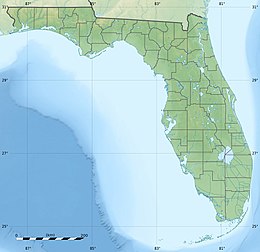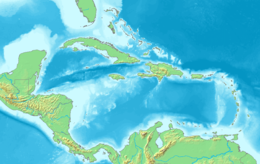
Back Кі-Ларга Byelorussian Key Largo (pulo) CEB Cayo Largo (isla) Spanish Key Largo Estonian Key Largo Finnish Key Largo (Floride) French קי לארגו HE キーラーゴ島 Japanese 키라르고섬 Korean Key Largo Turkish
 Key Largo | |
| Geography | |
|---|---|
| Location | Gulf of Mexico |
| Coordinates | 25°05′11″N 80°26′50″W / 25.0865°N 80.4473°W |
| Archipelago | Florida Keys |
| Adjacent to | Florida Straits |
| Administration | |
| State | Florida |
| County | Monroe |


Key Largo (Spanish: Cayo Largo) is an island in the upper Florida Keys archipelago and is the largest section of the keys, at 33 miles (53 km) long. It is one of the northernmost of the Florida Keys in Monroe County, and the northernmost of the keys connected by U.S. Highway 1 (the Overseas Highway). Three census-designated places (CDPs) are on the island of Key Largo: North Key Largo (near the Card Sound Bridge), Key Largo (roughly 8–9 miles (13–14 km) from the island's southernmost point) and Tavernier (at the island's south end). As of 2010, these three CDPs have a combined population of 13,850. None of Key Largo is an incorporated municipality; it is governed, at the local level, by Monroe County.
Key Largo is connected to the mainland of Miami-Dade County by two routes, the first being the Overseas Highway—the southernmost portion of U.S. Highway 1—which enters Key Largo at Jewfish Creek (near the middle of the island) before turning southwest. The second route is via Card Sound Road, which connects to the northern end of Key Largo and runs southeastward, connecting with County Road 905, which runs southwest and joins U.S. 1 at about mile marker 106. These routes originate at Florida City on the mainland.
Key Largo is a popular destination for many. It has been dubbed the "Diving Capital of the World" as the living coral reefs, a few miles offshore, attract thousands of scuba divers, sport-fishing enthusiasts and scientific researchers each year.[1]
Key Largo's proximity to the Everglades also makes it an ideal starting point for scientists, kayakers and ecotourists, among others. Automotive and highway pioneer (and Miami Beach developer) Carl G. Fisher built the Caribbean Club in 1938 as his last project.
Key Largo is situated between Everglades National Park, to the northwest, and John Pennekamp Coral Reef State Park, to the east, the first underwater park in the United States. The latter state park protects part of the Florida Reef, the only living coral barrier reef in the continental United States. Barrier reefs are critical to coastal communities and environments as they are able to dissipate up to 97%[2] of the oceanic wave forces exerted during hurricanes and other tropical storms, with the reef serving as a protective buffer against flooding further inland. The barrier reef, itself, provides over $675 million in storm surge protection, annually.[2]
- ^ "All About Diving in the Florida Keys, Florida Keys Scuba Diving". Flkeys-diving.com. 1997-07-01. Retrieved 2015-06-26.
- ^ a b "Coastal Protection - Florida's Coral Reef". www.FloridasCoralReef.org. Retrieved 25 April 2024.
…Because of the reef's ability to dissipate 97% of wave energy from storms and hurricanes, its conservation is critical to the protection of Florida's coastline and interconnected communities. Florida's Coral Reef buffers adjacent shorelines from wave action and prevents erosion, property damage and loss of life. The reef also protects the highly productive wetlands along the coast as well as ports and harbors and the economies they support. Florida's Coral Reef provides $675 million in flood protection benefits to the state each year. The continued protection of Florida's coastline and wetlands is vital.

